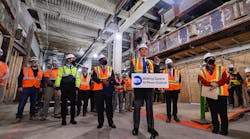New York City and the state of New York have reached an agreement on the financial framework to fund planned improvements to New York Penn Station and the surrounding area.
Three key points to the agreement include:
- Maintaining a current and consistent level of property tax revenue for New York City;
- Funding for the station, open space and public realm improvements will come in part from private development; and
- New York state is committed to delivering the proposed improvements to the station without raising taxes on New Yorkers or transit fares.
The agreement will see the establishment of a shared city-state governance entity to oversee public realm improvements and ensure planning and implementation of the project is comprehensive and coordinated.
In June, Empire State Development (ESD) created the Penn Station Area Public Realm Task Force to advise ESD on public realm improvements associated with the station improvement project. The task force includes members from state, transit and city government, as well as representatives from civic organizations and federal and state elected offices.
“The new vision for Penn Station is to our generation what the Empire State Building was to previous generations: a symbol of our resiliency and a project that will define our city for decades to come,” said New York City Mayor Eric Adams. “Today's agreement is a win-win for New Yorkers - helping to deliver improved transit access, affordable housing and quality jobs while also safeguarding future revenue and protecting against financial risk."
The (revised) plan
Former New York Gov. Andrew Cuomo long envisioned an expanded Penn Station and the new Moynihan Train Hall as a single Empire Station Complex. Last November, New York Gov. Kathy Hochul unveiled a revised version that focused on improving rather than expanding Penn Station. Gov. Hochul said her plan had commuters at its core and would contribute to a more livable city.
The proposal’s main features include a new train facility, improved transit access and shared, pedestrian friendly streets, affordable housing, social services and public space. The planned improvement for the station also includes simplified navigation, the addition of 18 escalators or stairs, 11 additional elevators and a 450-foot single level, double height train hall that will double passenger circulation space.
"The current Penn Station is unsightly, inefficient and impossible to navigate, and New York commuters deserve better," said Gov. Hochul. "This agreement brings us one step closer to a beautiful, modern station worthy of New York with vibrant open space, lively streetscapes and better, more seamless connections to local transit.”
Private development funding
The agreement requires private development to help fund station reconstruction and the potential expansion of the station, as well as improvements to the surrounding area, which include enhancements to the streets and sidewalks, the creation of new public spaces in the area around the station and the construction of transit connections between Penn and nearby subway stations.
New York state plans to sell development rights to private developers and collect payments-in-lieu-of-taxes (PILOTs) on newly constructed, modern and environmentally friendly office and residential buildings. The amount of PILOT payments collected in excess of existing property taxes, in addition to revenues from the sale of additional development rights, will help to fund the project.
The state and the city have agreed that PILOTs can be used to pay for up to:
- 100 percent of improvements to streets, sidewalks, public spaces and other elements of the public realm;
- 50 percent of improvements to transit infrastructure including underground concourses and subway entrances in the neighborhood; and
- 12.5 percent of the cost of the reconstruction and potential expansion of Penn Station.
Remaining costs would be funded through a combination of sources from the federal government, New Jersey, New York state, Amtrak and other public funding sources.
New York City will continue to collect amounts equal to current taxes on each development site with a three percent increase each year to maintain its tax revenue stream. The city says all buildings will return to its tax rolls after the agreed contributions to project costs are met or after a period of 80 years. The city anticipates increases in property values to generate more tax revenue once the buildings return to its tax rolls. Property tax abatements will be capped under the agreement.
Progress of Penn Station improvements
Last March, Metropolitan Transportation Authority (MTA) removed seven low-hanging beams, nicknamed head knockers, that limited heights of Penn Station passageways. The removal of the beams is part of MTA’s plans to increase the spaciousness of the Long Island Rail Road concourse at Penn Station.
In early June, MTA, New Jersey Transit (NJ Transit) and Amtrak issued a request for proposals from architecture and engineering firms to guide the reconstruction efforts at Penn Station in support of Gov. Hochul’s vision of the station.
In late June, Amtrak, in partnership with NJ Transit and in coordination with MTA, entered into a contract with Arup to begin designing options for the first new tracks, platforms and concourses connected to New York Penn Station in more than a century.







